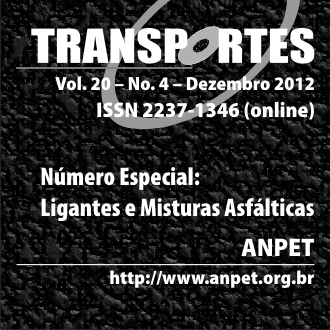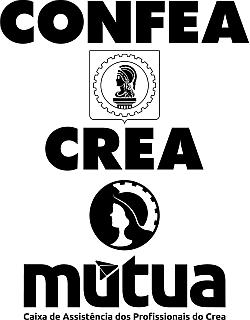Influence of the physical state of water in the diffusion process in asphalt binders
DOI:
https://doi.org/10.4237/transportes.v20i4.619Resumo
Moisture damage in asphalt mixtures is a complex phenomenon that involves mechanical, chemical, physical and thermodynamic processes. This damage contributes significantly to the premature deterioration of asphalt pavements, which leads to extra cost in highway maintenance and vehicle operations. One key mechanism of how moisture reaches the asphalt-aggregate interface is by its permeation or diffusion through the asphalt binder or mastic. For the asphalt-water system studied, the Fourier Transform Infrared (FTIR) – Attenuated Total Reflectance (ATR) spectrometry was used. Water shows strong absorption in the infrared region and the FTIR-ATR technique has the ability to monitor both the kinetics of moisture ingress as well as any chemical changes occurring during the test. This paper has the literature review and some results obtained in the comparison between water diffusion in the liquid state with the moisture (or vapor) state, both at room temperature.
Downloads
Referências
Arambula, E., Caro, S., and Masad, E. (2009). "Experimental Measurement and Numerical Simulation of Water Vapor Diffusion through Asphalt Pavement Materials." Journal of Materials in Civil Engineering, ASCE, submitted for evaluation.
Benjamin, I. (1994). "Vibrational Spectrum of Water at the Liquid/Vapor Interface." Physical Review Letters, 73(15), 2083.
Bertie, J. E., Labbe, H. J., and Whalley, E. (1969). "Absorptivity of Ice I in the Range 4000--30 cm[sup - 1]." The Journal of Chemical Physics, 50(10), 4501-4520.
Cheng, D. X., Little, D. N., Lytton, R. L., and Holste, J. C. (2003). "Moisture damage evaluation of asphalt mixtures by considering both moisture diffusion and repeated-load conditions." Bituminous Paving Mixtures 2003(1832), 42-49.
Du, Q., Superfine, R., Freysz, E., and Shen, Y. R. (1993). "Vibrational spectroscopy of water at the vapor/water interface." Physical Review Letters, 70(15), 2313.
Ewing, G. E., Foster, M., Cantrelll, W., and Sadtchenko, V. (2003). "Thin Film Water on Insulator Surfaces." Water in Confining Geometries, V. Buch and J. P. Devlin, eds., Springer-Verlag, Berlin, p. 179-211.
Falk, M., and Ford, T. A. (1966). "Infrared Spectrum and Structure of Liquid Water." Canadian Journal of Chemistry, 44, 1699-1707.
Griffiths, P. R., and de Haseth, J. A. (2007). Fourier Transform Infrared Spectrometry, Wiley-Interscience, a John Wiley & Sons Inc. Publication.
Jones IV, D. R. (1993). "SHRP Materials Reference Library: Asphalt Cements: A Concise Data Compilation." Report SHRP-A-645, Contract A-001, Strategic Highway Research Program, National Research Council, Washington, DC.
Kassem, E. A., Masad, E., Bulut, R., and Lytton, R. L. (2006). "Measurements of Moisture Suction and Diffusion Coefficient in Hot Mix Asphalt and their Relationships to Moisture Damage." Transportation Research Record: Journal of the Transportation Research Board, 1970, 45-54.
Kringos, N., Scarpas, A., and deBondt, A. (2008). "Determination of Moisture Susceptibility of Mastic-Stone Bond Strength and Comparison to Thermodynamical Properties." Journal of the Association of Asphalt Paving Technologists, 77, 435-478.
Nguyen, T., Byrd, E. W., Bentz, D., and Martin, J. (2005). "In Situ Spectroscopy Study of Water at the Asphalt/Siliceous Substrate Interface and Its Implication in Stripping." The Journal of Adhesion, 81, 1-28.
Sasaki, I., Moriyoshi, A., Hachiya, Y., and Nagaoka, N. (2006). "New test method for moisture permeation in bituminous mixtures." Journal of the Japan Petroleum Institute, 49(1), 33-37.
Shen, Y. R., and Ostroverkhov, V. (2006). "Sum-Frequency Vibrational Spectroscopy on Water Interfaces: Polar Orientation of Water Molecules at Interfaces." Chemical Reviews, 106(4), 1140-1154.
Vasconcelos, K. L., Bhasin, A., and Little, D. N. (2010). "Measurement of Water Diffusion in Asphalt Binders using the FTIR-ATR technique." Transportation Research Record, 2179, p. 29-38.
Wei, J. (2009). "Study on the Surface Free Energy of Asphalt, Aggregate and Moisture Diffusion in Asphalt Binder," China University of Petroleum, PhD.
Weis, D. D., and Ewing, G. E. (1998). "Absorption Anomalies in Ratio and Subtraction FT-IR Spectroscopy." Analytical Chemistry, 70(15), 3175-3183.
Wolf, R. V. (1991). Diffusion In and Through Polymers: Principles and Applications, Hanser Publishers, Munich Viennna New York Barcelona.
Downloads
Publicado
Como Citar
Edição
Seção
Licença
Ao submeter um manuscrito para publicação neste periódico, todos os seus autores concordam, antecipada e irrestritamente, com os seguintes termos:
- Os autores mantém os direitos autorais e concedem à Transportes o direito de primeira publicação do manuscrito, sem nenhum ônus financeiro, e abrem mão de qualquer outra remuneração pela sua publicação pela ANPET.
- Ao ser publicado pela Transportes, o manuscrito fica automaticamente licenciado sob a Licença Creative Commons CC BY 4.0. Esta licença permite o seu compartilhamento com reconhecimento da autoria e da publicação inicial neste periódico.
- Os autores têm autorização para assumir contratos adicionais separadamente, para distribuição não exclusiva da versão do trabalho publicada neste periódico (por ex.: publicar em repositório institucional ou como capítulo de livro), com reconhecimento da publicação inicial na Transportes, desde que tal contrato não implique num endosso do conteúdo do manuscrito ou do novo veículo pela ANPET.
- Os autores têm permissão e são estimulados a publicar e distribuir seu manuscrito online (por ex.: em repositórios institucionais ou na sua página pessoal) depois de concluído o processo editorial. Como a Transportes é de acesso livre, os autores são estimulados a usar links para o DOI do artigo nesses casos.
- Os autores garantem ter obtido a devida autorização dos seus empregadores para a transferência dos direitos nos termos deste acordo, caso esses empregadores possuam algum direito autoral sobre o manuscrito. Além disso, os autores assumem toda e qualquer responsabilidade sobre possíveis infrações ao direito autoral desses empregadores, isentando a ANPET e a Transportes de toda e qualquer responsabilidade neste sentido.
- Os autores assumem toda responsabilidade sobre o conteúdo do manuscrito, incluindo as devidas e necessárias autorizações para divulgação de dados coletados e resultados obtidos, isentando a ANPET e a Transportes de toda e qualquer responsabilidade neste sentido.










